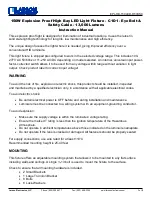
b)
The appliance is not intended to be used by people (including children) with
reduced mental, sensory or intellectual functions or lack of experience and/or
knowledge, unless they are supervised by a person responsible for their safety
or have been given instructions by them on how to operate the appliance.
c)
The appliance may only be operated by people who are physically fit, capable
of handling it and who have been adequately trained, who have read these
instructions and have received training in health and safety.
d)
Be careful and use common sense when operating the appliance. A short
moment of distraction during operation may lead to serious personal injury.
e)
Use the required personal protective equipment when working with the
appliance (as specified in section 1 of the explanation of symbols). The use of
appropriate, approved personal protective equipment reduces the risk of
injury.
f)
Do not overestimate your capabilities. Maintain body balance at all times
during operation. This allows for better control of the appliance in unexpected
situations.
g)
Do not wear loose clothing or jewellery. Keep hair, clothing and gloves away
from moving parts. Loose clothing, jewellery or long hair can be caught by
moving parts.
h)
Remove all adjusting tools or wrenches before turning the appliance on. A tool
or wrench left in the rotating part of the appliance may cause injury.
i)
It is advisable to wear eye, ear and respiratory protection.
j)
The appliance is not a toy. Children should be supervised to ensure that they
do not play with it.
k)
Do not put your hands or objects inside the operating appliance!
l)
When working with the appliance, wear suitable footwear and long trousers.
It is forbidden to use the appliance with bare feet or wearing sandals and
similar footwear.
m)
Always ensure that the ventilation openings are free from impurities (e.g.
stones, grass residues, branches, leaves).
n)
It is forbidden to run with the appliance; it should manoeuvred slowly.
2.4.
Safe operation
a)
Do not overload the appliance. Use tools that are suitable for the given
application. A correctly selected appliance ensures better and safer
performance of work.
b)
Do not use the appliance if the ON/OFF switch does not function properly
(does not switch on and off). Appliances that cannot be controlled by the
switch are dangerous, cannot be operated and must be repaired.
c)
The appliance must be disconnected from the power supply before
adjustment, cleaning and maintenance. This preventive measure reduces the
risk of accidental activation.
















































